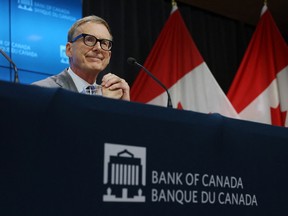Strip out mortgage costs, and inflation for the other 95% of the pricing pie is at the central bank’s target of 2%
Article content
Of course, the inflation-phobes will never be silenced and are saying that inflation is being skewed down by gasoline, that the process is about to stop and that the depressed year-ago base effects will reverse course (true, but only for the next three months).
Advertisement 2
Article content
But let’s stick to the facts. The consumer price index (not seasonally adjusted) came in at +0.1 per cent month over month in June and the same economists fretting over the situation were calling for +0.3 per cent. The headline inflation rate was supposed to ease to +3.0 per cent but instead softened to +2.8 per cent (from +3.4 per cent in May) to stand at the lowest pace since March 2021. On a month-over-month seasonally-adjusted basis, the CPI came in at just +0.1 per cent as well and that followed 0.0 per cent in May for the weakest back-to-back pulse in three years.
Article content
For all the talk of how this is all just a gasoline story, the core CPI came in at +0.1 per cent for the second month in a row as well, and we haven’t seen something like this since February-March 2021, which was a full year before the Bank of Canada took on this John Crow-type of aggressive policy tightening cycle.
Article content
Advertisement 3
Article content
The core rate of inflation (excluding food and energy) has declined now for seven months in a row — from +5.4 per cent a year ago to +3.6 per cent today (was +3.8 per cent in May). The six-month trend is down to a +2.9 per cent annual rate, and over the three months to June, now at a mere +2.5 per cent. But the policy hawks will focus on the key Bank of Canada core measures, which came in a bit hotter at +0.3 per cent sequentially and is sitting too high for the central bank’s liking at +3.9 per cent year over year for the median and +3.7 per cent for the trimmed-mean metric. While both peaked near 5.5 per cent, the improvement has been on the slow side as of late.
That said, I did find quite a few positive tidbits in the CPI report. The index that strips out the eight most volatile items and indirect taxes came in at less than +0.1 per cent month over month (+0.07 per cent to the second decimal place) after a similar uptick in May. The year-over-year trend here was +6.1 per cent a year back, slowed to +3.6 per cent in May, and now to +3.2 per cent in June. The three-month and six-month paces are down to +2.7 per cent at an annual rate, which is encouraging in that the month-over-month momentum is subsiding in this underlying inflation barometer.
Advertisement 4
Article content
We have this situation on our hands where the Bank of Canada itself is causing the inflation it is so worried about. Mortgage interest surged +1.6 per cent month over month and by +30.14 per cent from year-ago levels — strip this out, and the year-over-year inflation rate is at the bank’s two per cent target right on the nose. The core is at +2.4 per cent, but the three- and six-month trends are south of a +2.0 per cent annual rate on this score.
That is the key: strip out mortgage costs, and the other 95 per cent of the pricing pie is down to the bank’s target of two per cent. The central bank, hopefully, can see this. It has talked the markets into thinking another one or two more rate hikes are coming — that would be a mistake, in my opinion — completely unnecessary. But like the United States Federal Reserve, the Bank of Canada is focused squarely on lagging and contemporaneous economic indicators — a recession is still the odds-on bet.
Advertisement 5
Article content
One other thing which should be very beneficial, especially since ex-shelter inflation also is back to two per cent, is that we are seeing a very nice supply response in the Canadian housing industry, which should help alleviate the shortages and ease this pressure on the CPI data.
Housing starts soared a record +40.7 per cent month over month in June to a nine-month high of 281,400 annualized units.
Given the strength in multiple-unit starts, up a resounding +58.7 per cent month over month and +12.5 per cent year over year to a near-record (second highest ever) of 220,000 annualized units, one can reasonably expect the rental measures to play a big future disinflationary role even if there is to be no more relief on the energy front.
David Rosenberg is founder and president of independent research firm Rosenberg Research & Associates Inc. To receive more of David Rosenberg’s insights and analysis, you can sign up for a complimentary, one-month trial on the Rosenberg Research website.
Article content
Rosenberg: The only inflation left is being caused by Bank of Canada
2023-07-19 16:42:16






Comments
Postmedia is committed to maintaining a lively but civil forum for discussion and encourage all readers to share their views on our articles. Comments may take up to an hour for moderation before appearing on the site. We ask you to keep your comments relevant and respectful. We have enabled email notifications—you will now receive an email if you receive a reply to your comment, there is an update to a comment thread you follow or if a user you follow comments. Visit our Community Guidelines for more information and details on how to adjust your email settings.
Join the Conversation